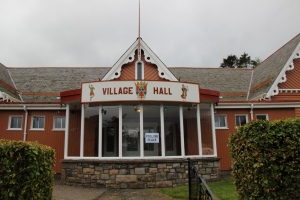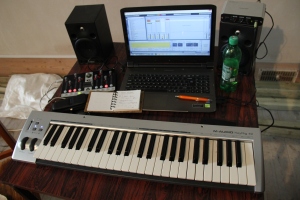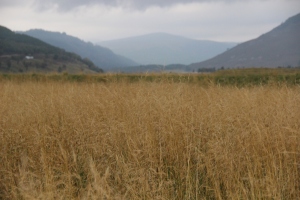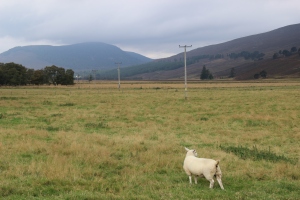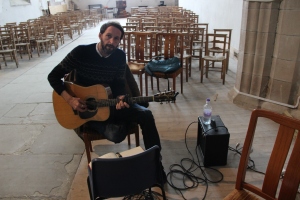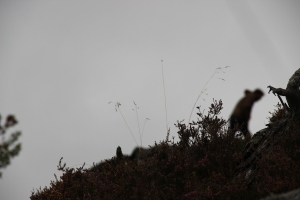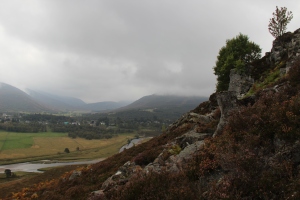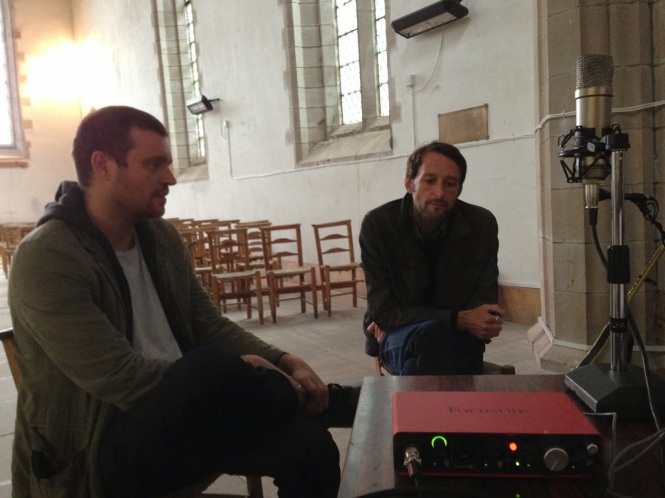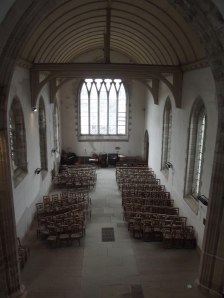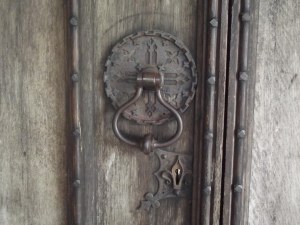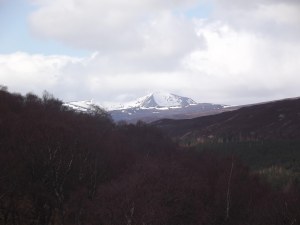I arrived in a very autumnal Braemar on the 20th October for a final residency week with Alasdair Roberts. In our previous residency we had decided upon a final running order but still had some refining to do to our arrangement of Queen Victoria’s Welcome to Deeside.
Our host, Andrew Braidwood, did a wonderful job at setting up the equipment in St Margaret’s Church that we would need for our performance (held on the 26th October). The church was often bitterly cold and I was glad to have invested in a pair of fingerless gloves before leaving Aberdeen.
On our first full day in Braemar, Alasdair and I decided to revisit Queen Victoria’s Welcome to Deeside. We felt that the arrangement was missing something and Alasdair struck upon the idea of having the sound of a cat purring – this, of course, being a reference to David Cameron’s nauseating description of Queen Elizabeth’s reaction to the Scottish Referendum outcome. I was able to find a recording online of a cat contentedly purring which I subsequently ran on a rhythmic loop while Alasdair and I performed a horribly jovial accompaniment.
We both felt that the set was complete and all that was left to do was rehearse before the final performance.
Our residency week happened to coincide with the Braemar Creative Arts Festival. The festival included craft sales, a knitted bird treasure hunt, workshops focusing on poetry, music and step dancing and an impressive concert and ceilidh which was held in the village hall on Saturday 25th. I particularly enjoyed learning a new dance: “The East Kilbride All-Together”. It was great to have a night to really unwind before the day of our concert.
On Sunday afternoon, Alasdair and I arrived at St Margaret’s to find the church buzzing with activity. A local gentleman, John McAllister, very kindly did our lighting – which was wonderfully atmospheric – and prepared a makeshift projection screen for a short video I had started creating during our previous residency. The video consisted of time-lapse and slow-motion shots of the surrounding area and was accompanied by a highly abstracted recording of Alasdair jamming on guitar. We decided to have this playing as people arrived as a means of creating an ambience. The video can be viewed below:
By 6pm the church had filled to a capacity that I certainly hadn’t anticipated given the somewhat remote location of Braemar and also the very wild and wet weather conditions that evening. It was rather lovely to see a lot of the faces we’d come to recognise throughout our time in the village as well as friends and family who had travelled larger distances to hear us perform.
After a short introduction by Fiona Robertson from Sound Festival, Alasdair and I opened our set with The Seasons. This was a somewhat apt choice as it had been the very first song that we worked on. Our setting of this song opens with a repeating chord progression (E/F#m/A) on the harmonium with a solo guitar melody. As Alasdair sang the verses, I gradually began to digitally process his voice – sometimes distorting it or adding a delay effect. The song culminated in a looped recording of Alasdair singing the words “I’m dreaming of the summer…” which eventually faded to silence.
Our second song was an arrangement of The Cruel Mother – a well-known ballad with a grisly narrative. Technically, for me, this was the most difficult performance to execute successfully. It opens with a multi-layered choral sound (this was, in fact, a recording of Alasdair singing a single note that I stretched out to several minutes in length and transposed multiple times). As this slowly decays, a repeating piano refrain in a high register emerges and Alasdair begins singing with interspersed guitar solos. As the song progresses, I begin adding to the existing arpeggiated piano pattern until it eventually encompasses the entire range of the instrument. During this I add a distorted effect to Alasdair’s vocals – specifically when he sings the line “doon by the greenwood-side-y-o”. All the while the opening choral effect gradually reemerges and the sense of unease increases.
This was followed by our rendition of Billy Taylor. For this ballad, I had made use of recordings taken around Braemar during our first residency – including the sound of St Margaret’s Church’s door knocker striking. These sounds were combined and edited in order to create a driving percussive rhythm over which Alasdair could perform. I thoroughly enjoy performing this song. There is a great deal of drama in the song’s narrative which Alasdair expresses brilliantly – both vocally and in his guitar accompaniment.
False, False is a deeply sombre song – or at least our approach to it is as such. For this song, we again employed the harmonium – this time playing a repeating descending minor chord progression, pre-recorded and layered upon. I think the way that Alasdair and I chose to structure the development of this song proved to be a somewhat cathartic performative experience for the both of us. For the most part, I am able to set the chord progression in motion, sit back and enjoy Alasdair’s performance. By the time he has finished singing, I have sampled random sections of his performance and can then begin to loop and distort what has been recorded, allowing Alasdair to stand back and listen to the outcome. It’s a very unusual duet…
The penultimate song in the set, Queen Victoria’s Welcome to Deeside is perhaps the most “traditional”-sounding song that we performed – at least, in places. My piano accompaniment is reminiscent of how certain elderly music teachers might play (a lot of pretty cadences). The prettiness is interrupted by an unnaturally-stretched sample of Alasdair singing the word “queen”, a cacophony of church bells and the aforementioned cat-purring, before we conclude with a ridiculously jolly waltz. I’m still unclear as to how this arrangement was received by the audience.
We finished our set with The Baron of Brackley – a ballad which is particularly relevant to the surrounding area of Braemar. Despite the unfortunate outcome of the eponymous Baron and the seemingly corrupt intentions of his wife, our arrangement of the song has a rather upbeat mood to it.
Our performance seemed to be warmly received and the post-show discussion raised some very interesting issues – including the influence of location and landscape on creative practice, the challenges of bringing together practitioners from two very different genres, and the general process of creative collaboration over a four-week period (spread across three seasons).
Alasdair and I will be performing together in Edinburgh on the 1st January 2015 as part of…. Beyond that, we have discussed the possibility of attaining funding to allow us to make a professional recording of the songs we’ve worked on this year. Regardless of the outcome, I am happy to have made a new friend and to have produced some beautiful music with him.
I arrived in a very autumnal Braemar on the 20th October for a final residency week with Alasdair Roberts. In our previous residency we had decided upon a final running order but still had some refining to do to our arrangement of Queen Victoria’s Welcome to Deeside.
Our host, Andrew Braidwood, did a wonderful job at setting up the equipment in St Margaret’s Church that we would need for our performance (held on the 26th October). The church was often bitterly cold and I was glad to have invested in a pair of fingerless gloves before leaving Aberdeen.
On our first full day in Braemar, Alasdair and I decided to revisit Queen Victoria’s Welcome to Deeside. We felt that the arrangement was missing something and Alasdair struck upon the idea of having the sound of a cat purring – this, of course, being a reference to David Cameron’s nauseating description of Queen Elizabeth’s reaction to the Scottish Referendum outcome. I was able to find a recording online of a cat contentedly purring which I subsequently ran on a rhythmic loop while Alasdair and I performed a horribly jovial accompaniment.
We both felt that the set was complete and all that was left to do was rehearse before the final performance.
Our residency week happened to coincide with the Braemar Creative Arts Festival. The festival included craft sales, a knitted bird treasure hunt, workshops focusing on poetry, music and step dancing and an impressive concert and ceilidh which was held in the village hall on Saturday 25th. I particularly enjoyed learning a new dance: “The East Kilbride All-Together”. It was great to have a night to really unwind before the day of our concert.
On Sunday afternoon, Alasdair and I arrived at St Margaret’s to find the church buzzing with activity. A local gentleman, John MacPherson, very kindly did our lighting – which was wonderfully atmospheric – and prepared a makeshift projection screen for a short video I had started creating during our previous residency. The video consisted of time-lapse and slow-motion shots of the surrounding area and was accompanied by a highly abstracted recording of Alasdair jamming on guitar. We decided to have this playing as people arrived as a means of creating an ambience. The video can be viewed below:
By 6pm the church had filled to a capacity that I certainly hadn’t anticipated given the somewhat remote location of Braemar and also the very wild and wet weather conditions that evening. It was rather lovely to see a lot of the faces we’d come to recognise throughout our time in the village as well as friends and family who had travelled larger distances to hear us perform.
After a short introduction by Fiona Robertson from Sound Festival, Alasdair and I opened our set with The Seasons. This was a somewhat apt choice as it had been the very first song that we worked on. Our setting of this song opens with a repeating chord progression (E/F#m/A) on the harmonium with a solo guitar melody. As Alasdair sang the verses, I gradually began to digitally process his voice – sometimes distorting it or adding a delay effect. The song culminated in a looped recording of Alasdair singing the words “I’m dreaming of the summer…” which eventually faded to silence.
Our second song was an arrangement of The Cruel Mother – a well-known ballad with a grisly narrative. Technically, for me, this was the most difficult performance to execute successfully. It opens with a multi-layered choral sound (this was, in fact, a recording of Alasdair singing a single note that I stretched out to several minutes in length and transposed multiple times). As this slowly decays, a repeating piano refrain in a high register emerges and Alasdair begins singing with interspersed guitar solos. As the song progresses, I begin adding to the existing arpeggiated piano pattern until it eventually encompasses the entire range of the instrument. During this I add a distorted effect to Alasdair’s vocals – specifically when he sings the line “doon by the greenwood-side-y-o”. All the while the opening choral effect gradually reemerges and the sense of unease increases.
This was followed by our rendition of Billy Taylor. For this ballad, I had made use of recordings taken around Braemar during our first residency – including the sound of St Margaret’s Church’s door knocker striking. These sounds were combined and edited in order to create a driving percussive rhythm over which Alasdair could perform. I thoroughly enjoy performing this song. There is a great deal of drama in the song’s narrative which Alasdair expresses brilliantly – both vocally and in his guitar accompaniment.
False, False is a deeply sombre song – or at least our approach to it is as such. For this song, we again employed the harmonium – this time playing a repeating descending minor chord progression, pre-recorded and layered upon. I think the way that Alasdair and I chose to structure the development of this song proved to be a somewhat cathartic performative experience for the both of us. For the most part, I am able to set the chord progression in motion, sit back and enjoy Alasdair’s performance. By the time he has finished singing, I have sampled random sections of his performance and can then begin to loop and distort what has been recorded, allowing Alasdair to stand back and listen to the outcome. It’s a very unusual duet…
The penultimate song in the set, Queen Victoria’s Welcome to Deeside is perhaps the most “traditional”-sounding song that we performed – at least, in places. My piano accompaniment is reminiscent of how certain elderly music teachers might play (a lot of pretty cadences). The prettiness is interrupted by an unnaturally-stretched sample of Alasdair singing the word “queen”, a cacophony of church bells and the aforementioned cat-purring, before we conclude with a ridiculously jolly waltz. I’m still unclear as to how this arrangement was received by the audience.
We finished our set with The Baron of Brackley – a ballad which is particularly relevant to the surrounding area of Braemar. Despite the unfortunate outcome of the eponymous Baron and the seemingly corrupt intentions of his wife, our arrangement of the song has a rather upbeat mood to it.
Our performance seemed to be warmly received and the post-show discussion raised some very interesting issues – including the influence of location and landscape on creative practice, the challenges of bringing together practitioners from two very different genres, and the general process of creative collaboration over a four-week period (spread across three seasons).
Alasdair and I will be performing together in Edinburgh on the 1st January 2015 as part of…. Beyond that, we have discussed the possibility of attaining funding to allow us to make a professional recording of the songs we’ve worked on this year. Regardless of the outcome, I am happy to have made a new friend and to have produced some beautiful music with him.

